Related Research Articles

Metropolitan Manila, officially the National Capital Region, is the seat of government and one of three defined metropolitan areas in the Philippines. It is composed of 16 highly urbanized cities: the city of Manila, Quezon City, Caloocan, Las Piñas, Makati, Malabon, Mandaluyong, Marikina, Muntinlupa, Navotas, Parañaque, Pasay, Pasig, San Juan, Taguig, and Valenzuela, as well as the municipality of Pateros. The region encompasses an area of 619.57 square kilometers (239.22 sq mi) and a population of 13,484,462 as of 2020. It is the second most populous and the most densely populated region of the Philippines. It is also the 9th most populous metropolitan area in Asia and the 5th most populous urban area in the world.
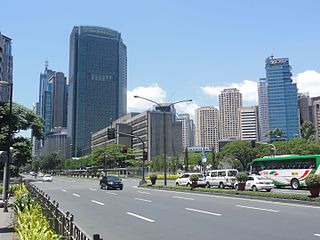
Makati, officially the City of Makati, is a 1st class highly urbanized city in the National Capital Region of the Philippines.
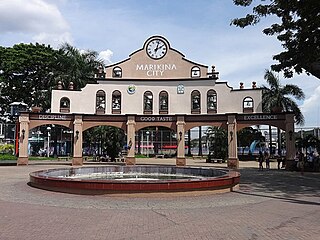
Marikina, officially the City of Marikina, is a 1st class highly urbanized city in the National Capital Region of the Philippines. According to the 2020 census, it has a population of 456,159 people.

Epifanio de los Santos Avenue, commonly referred to by its acronym EDSA, is a limited-access circumferential highway around Manila, the capital city of the Philippines. It passes through 6 of Metro Manila's 17 local government units or cities, namely, from north to south, Caloocan, Quezon City, San Juan, Mandaluyong, Makati, and Pasay.

SM Mall of Asia, also abbreviated as SM MoA, or simply Mall of Asia or MoA, is a large shopping mall in the Philippines, located at Bay City, Pasay, Philippines, within the SM Central Business Park, a reclaimed area within Manila Bay, and the southern end of Epifanio de los Santos Avenue (EDSA).

Eastwood City is a 18.5 hectares mixed-use development complex located in Barangay Bagumbayan Quezon City. Launched in 1997, it is Megaworld Corporation’s first “live-work-play” community that offers complete facilities, amenities, and establishments for living, working, playing, and shopping.

Bay City, also known as the Manila Bay Freeport Zone and Manila Bay Area, is the name for the reclamation area on Manila Bay located west of Roxas Boulevard and the Manila–Cavite Expressway in Metro Manila, the Philippines. The area is split between the cities of Manila and Pasay on the north side and Parañaque on the south.
Robinsons Malls is one of the largest shopping malls and retail operators in the Philippines. It was incorporated on September 9, 1997, by entrepreneur John Gokongwei Jr. to develop, conduct, operate and maintain the Robinsons commercial shopping centers and all related businesses, such as the lease of commercial spaces within the compound of shopping centers.

Ayala Malls is a retail subsidiary of real estate company Ayala Land, an affiliate of Ayala Corporation. Founded in 1988, Ayala Malls own a chain of large shopping malls, all located in the Philippines. Ayala Malls is the one of the largest shopping mall retailer in the Philippines, along with SM Supermalls and Robinsons Malls.

The U.P.–Ayala Land TechnoHub is an information technology hub jointly developed by the University of the Philippines Diliman and property developer Ayala Land. It is located in Commonwealth Avenue, Barangay U.P. Campus, Quezon City. It occupies 20 hectares within the 37.5 hectares of the U.P. North Science and Technology Park.

Entertainment City, also known as E-City, is a gaming and entertainment complex under development by PAGCOR spanning an area of 8 km2 (3.1 sq mi) in Bay City, Metro Manila, Philippines. It was first envisioned by PAGCOR in 2002. Alongside the Aseana City business development, it lies at the western side of Roxas Boulevard and south of SM Central Business Park, part of Parañaque.

Riverbanks Center is an integrated development complex for shopping, recreational, business and commercial along Andres Bonifacio Avenue adjacent to Marikina River in Barangka, Marikina, Metro Manila, Philippines. It is home of the Philippine's biggest outdoor amphitheater and outlet center, and the location of once the world's largest pair of shoes.
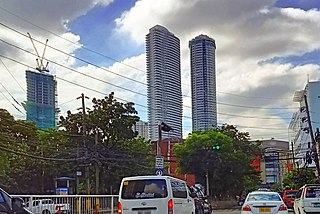
Capitol Commons is a mixed-use development in Oranbo, Pasig, Metro Manila, Philippines. It is a redevelopment of the former Rizal Provincial Capitol complex located in the village of Oranbo adjacent to the Ortigas Center financial district. The 10-hectare (25-acre) site being developed by Ortigas & Company Limited Partnership, the same developer behind Ortigas Center, features Pasig's first high-end shopping center called Estancia at Capitol Commons. Once completed, the P25-billion mixed-use commercial, residential and office development will have 35,000 square meters (380,000 sq ft) of retail space, 20,000 square metres (220,000 sq ft) of office space for knowledge process outsourcing (KPO) companies, and 280,000 square meters (3,000,000 sq ft) of residential units. The development is also home to the Capitol Commons Park, which takes up fifty percent of the development.

The Cultural Center of the Philippines Complex, also known as the CCP Complex, is an 88-hectare (220-acre) reclaimed property owned by the Cultural Center of the Philippines (CCP) located along Roxas Boulevard in Metro Manila, Philippines. It is a mixed-use cultural and tourism hub overlooking Manila Bay in south-central Manila, most of which fall under the jurisdiction of the city of Pasay.
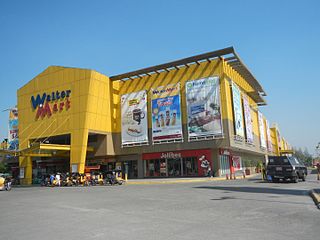
Walter Mart is a Filipino chain of community shopping malls located in Metro Manila, Central, and South Luzon. The chain operates its anchor stores that include Walter Mart Supermarket, Walter Mart Cinemas, Abenson Appliances, Homeplus Furniture, Electroworld, and SB Furnitures. Filipino retail stores such as Watsons, Ace Hardware, Robinsons Department Store, and W Department Store are also occupying most of Walter Mart's branches.
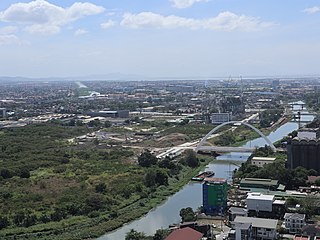
Parklinks is a 35-hectare (86-acre) mixed-use development that straddles the Pasig–Quezon City boundaries in the Philippines. It is a joint project of LT Group and Ayala Land located on the banks of the Marikina River in the eastern part of Metro Manila. The riverfront development is the biggest along the segment of C-5 Road north of the Pasig River and is planned to contain a 3-hectare (7.4-acre) central urban park, an esplanade, river terrace, riparian gardens and bike trails designed to make it one of the greenest urban estates in the Manila metropolitan area.
Bridgetowne is a real estate development spanning the border of Pasig and Quezon City in Metro Manila, the Philippines. It is a mixed township and business park situated in a former industrial area on both banks of the Marikina River near the junction of Eulogio Rodriguez Jr. Avenue and Ortigas Avenue. The 30.61-hectare (75.6-acre) masterplanned community is the first integrated township project by Robinsons Land Corporation, the real estate arm of JG Summit. It is currently anchored by four office towers in its information technology park dedicated to the business process outsourcing sector, its second in Metro Manila after Robinsons Cybergate in Mandaluyong. Once completed, the township will be a community consisting of seven office towers, a shopping mall, five-star hotel and residential condominiums, with a landmark bridge and a light art installation called The Victor as its centerpiece.

The COVID-19 pandemic in Metro Manila is part of the worldwide pandemic of coronavirus disease 2019 caused by severe acute respiratory syndrome coronavirus 2. The virus reached Metro Manila on January 30, 2020, when the first case of COVID-19 in the Philippines was confirmed in Manila. Metro Manila is the worst affected region in the Philippines, where most cases are recorded in the country. A state of calamity and community quarantine have been in place in the region since March 15.
References
- ↑ Idyllic township soon to rise in Marikina City, Philippine Daily Inquirer .
- 1 2 3 Retailers see the potential of FedLand's Blue Wave Mall Archived 12 June 2012 at the Wayback Machine , Manila Bulletin .
- ↑ Federal Land's Marquinton Residences rising fast, Philippine Daily Inquirer .
- 1 2 3 Federal Land commercial zone makes waves in Marikina City, Philippine Daily Inquirer .
- ↑ A community for raising a family in Marikina Archived 12 June 2012 at the Wayback Machine , Manila Bulletin .
- 1 2 Philippine Economic Zone Authority: Operating Economic Zones: IT Parks/Centers Archived 21 November 2011 at the Wayback Machine
- ↑ NCO Group: Fact Sheet Archived 27 November 2010 at the Wayback Machine
- ↑ US BPO eyes 2 more RP sites Archived 7 December 2010 at the Wayback Machine , Philippine Daily Inquirer .
- ↑ NCO opens Philippines call center, Philadelphia Business Journal
- ↑ Philippine Economic Zone Authority: Economic Zones Being Developed: IT Parks/Centers Archived 4 June 2011 at the Wayback Machine
- ↑ Armed men in military uniform rob Marikina bank Archived 5 October 2012 at the Wayback Machine , Philippine Daily Inquirer .
- ↑ Three of 5 mall robbers identified, The Philippine Star .